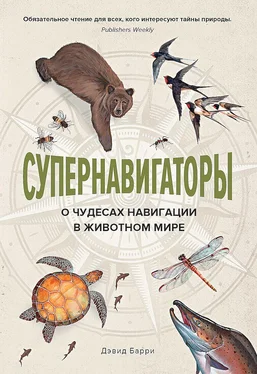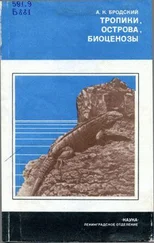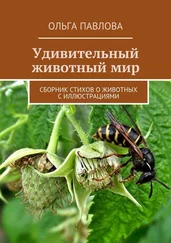Debose, J. L., & Nevitt, G. A. (2008). ‘The use of odors at different spatial scales: comparing birds with fish’, Journal of Chemical Ecology, 34 (7). P. 867–881. http://doi.org/10.1007/s10886–008–9493–4.
Nevitt, G. A., & Bonadonna, F. (2005). Sensitivity to dimethyl sulphide suggests a mechanism for olfactory navigation by seabirds’, Biology Letters, 1 (3). P. 303–305.
Pachyptila desolata.
Mouritsen, H. (2018). ‘Long-distance navigation and magnetoreception in migratory animals’, Nature, 558 (7708). P. 50.
Benhamou, S., Bried, J., Bonadonna, F., & Jouventin, P. (2003). ‘Homing in pelagic birds: a pilot experiment with white-chinned petrels released in the open sea’, Behavioural Processes, 61 (1–2). P. 95–100; Bonadonna, F., Bajzak, C., Benhamou, S., Igloi, K., Jouventin, P., Lipp, H. P., & Dell’Omo, G. (2005). ‘Orientation in the wandering albatross: interfering with magnetic perception does not affect orientation performance’, Proceedings of the Royal Society of London B: Biological Sciences, 272 (1562). P. 489–495.
Mora, C. V., Davison, M., Wild, J. M., & Walker, M. M. (2004).’Magnetoreception and its trigeminal mediation in the homing pigeon’, Nature, 432 (7016). P. 508.
Wallraff, H. G. (1980). ‘Does pigeon homing depend on stimuli perceived during displacement?’, Journal of Comparative Physiology A: Neuroethology, Sensory, Neural, and Behavioral Physiology, 139 (3). P. 193–201.
См., например, Wiltschko, R., & Wiltschko, W. (2017). ‘Considerations on the role of olfactory input in avian navigation’, Journal of Experimental Biology, 220 (23). P. 4347–4350.
Fratercula arctica.
Guilford, T., Freeman, R., Boyle, D., Dean, B., Kirk, H., Phillips, R., & Perrins, C. (2011). ‘A dispersive migration in the Atlantic puffin and its implications for migratory navigation’, PLoS One, 6 (7), e21336.
Plectrophenax nivalis.
Gatty, H., Finding Your Way Without Map or Compass (Dover Books, 1983). P. 78, 79.
Konishi, M. (1993). ‘Listening with two ears’, Scientific American, 268 (4). P. 66–73.
Wilson, Clare, ‘Human bat uses echoes and sounds to see the world’, New Scientist, 6 May 2015.
См.: Flanagin, V. L., Schörnich, S., Schranner, M., Hummel, N., Wallmeier, L., Wahlberg, M., … & Wiegrebe, L. (2017). ‘Human exploration of enclosed spaces through echolocation’, Journal of Neuroscience, 37 (6). P. 1614–1627; и Thaler, L., Reich, G. M., Zhang, X., Wang, D., Smith, G. E., Tao, Z., et al. (2017). ‘Mouth-clicks used by blind expert human echolocators — signal description and model-based signal synthesis’, PLoS Comput Biol., 13 (8), e1005670.
См.: Balcombe, J., What a Fish Knows: The Inner Lives of our Underwater Cousins (Scientific American/Farrar, Straus and Giroux, 2016). P. 44.
Kemp, Christopher, ‘The original batman’, New Scientist, 15 November 2017.
Griffin, D. R., Webster, F. A., & Michael, C. R. (1960). The echolocation of flying insects by bats. Animal Behaviour, 8 (3–4). P. 141–154.
Сипухи также способны находить добычу в темноте, полагаясь только на слух. Они способны различать чрезвычайно слабый шум, который производят мыши и землеройки, пробирающиеся в траве, и определять их местоположение с поразительной точностью.
См.: Ulanovsky, N., & Moss, C. F. (2008). ‘What the bat’s voice tells the bat’s brain’, Proceedings of the National Academy of Sciences, 105 (25). P. 8491–8498.
Waterman, T. H., Animal Navigation (Scientific American Library, 1989). P. 131–133.
Verfuß, U. K., Miller, L. A., & Schnitzler, H. U. (2005). ‘Spatial orientation in echolocating harbour porpoises (Phocoena phocoena)’, Journal of Experimental Biology, 208 (17). P. 3385–3394.
Kreithen, M. L., & Quine, D. B. (1979). ‘Infrasound detection by the homing pigeon: a behavioral audiogram’, Journal of Comparative Physiology, 129 (1). P. 1–4.
Я сам часто слышал очень громкое двойное «бум-бум» «Конкорда», когда находился в море, посреди Ла-Манша.
Hagstrum, J. T. (2000). ‘Infrasound and the avian navigational map’, Journal of Experimental Biology, 203 (7). P. 1103–1111.
См.: Grant, U. S. (1895), Personal Memoirs of U. S. Grant. Sampson Low, ch. 28. Другие примеры: www.nellaware.com/blog/acoustic-shadow-in-the-civil-war.html.
Hagstrum, J. T. (2013). ‘Atmospheric propagation modeling indicates homing pigeons use loft-specific infrasonic ‘map’ cues’, Journal of Experimental Biology, 216 (4). P. 687–699.
Quine, D. B., & Kreithen, M. L. (1981). ‘Frequency shift discrimination: Can homing pigeons locate infrasounds by Doppler shifts?’, Journal of Comparative Physiology, 141 (2). P. 153–155.
Wallraff, H. G. (1972). ‘Homing of pigeons after extirpation of their cochleae and lagenae’, Nature, 236 (68). P. 223, 224.
Hagstrum, J. T., & Manley, G. A. (2015). ‘Releases of surgically deafened homing pigeons indicate that aural cues play a significant role in their navigational system’, Journal of Comparative Physiology A, 201 (10). P. 983–1001.
Hagstrum, J. T., McIsaac, H. P., & Drob, D. P. (2016). ‘Seasonal changes in atmospheric noise levels and the annual variation in pigeon homing performance’, Journal of Comparative Physiology A, 202 (6). P. 413–424.
Arctocephalus gazella.
Hoffman, J. I., & Forcada, J. (2012). ‘Extreme natal philopatry in female Antarctic fur seals (Arctocephalus gazella)’, Mammalian Biology-Zeitschrift für Säugetierkunde, 77 (1). P. 71–73.
Callorhinus ursinus.
Ibid.
Подробное обсуждение этой темы см.: Taylor, E.G.R., The Haven-Finding Art: A History of Navigation from Odysseus to Captain Cook (Hollis and Carter, 1956), ch. 5.
На самом деле геомагнитное поле возникает в результате взаимодействия жидкого внешнего ядра с загадочным первичным магнитным полем внутреннего ядра. Я благодарен Йону Хагструму, обратившему мое внимание на это обстоятельство.
Читать дальше







![Дэвид Барри - Супернавигаторы [О чудесах навигации в животном мире] [litres]](/books/393891/devid-barri-supernavigatory-o-chudesah-navigacii-v-thumb.webp)

![Барри Пэйн - Новый Гулливер [Затерянные миры. Том XXIV]](/books/406917/barri-pejn-novyj-gulliver-zateryannye-miry-tom-xx-thumb.webp)


